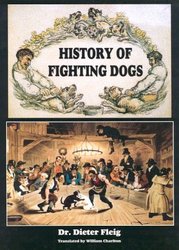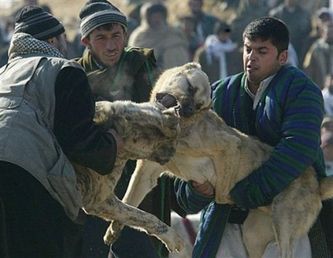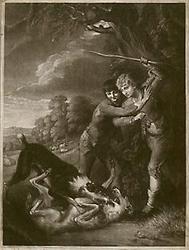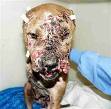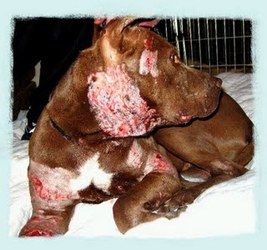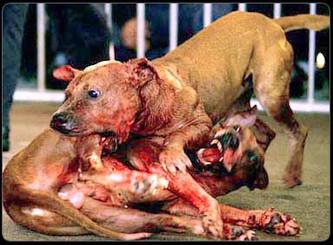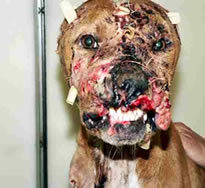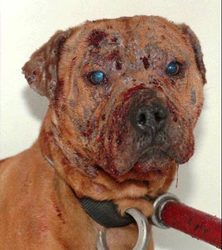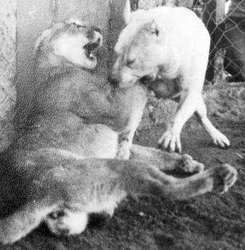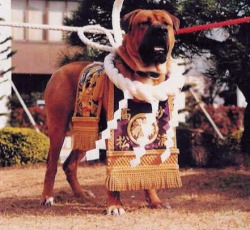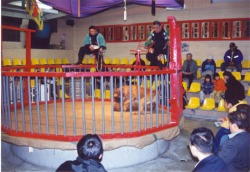WARNING!!! SOME GRAPHIC IMAGES BELOW
Dog Fighting
Brought to light recently in the aftermath of the Michael Vick case, many Americans are more aware of the blood sport that takes place behind so many closed doors in America, and often in the open in other countries. In Japan, breeds like the Akita Inu and Tosa Inu were bred to participate in the ceremonial dog fights. In fact, dog fighting is still legal in Japan and there are a lot of regulations designed to protect the animal.
Pit bulls are not the only dogs used in this sick sport of pitting dogs on dogs.
Below is a list, adapted from http://hubpages.com/hub/fightingdogs:
Caucasian Ovtcharka
The fighting strains of the Caucasian Ovcharka can contain blood of some European breeds, from mastiffs to American Pit Bull Terriers and Bandogs, but these crosses are a minority in the breed. These dogs were used for centuries to protect properties, guard livestock, kill wolves, hunt bears and for many other duties.
Cane Corso
The Cane Corso's history is shrouded in mystery and differing opinions. It is generally agreed that the Cane Corso is a farm dog which has been used for stock control, property, guard dogs and big game hunting throughout its Italian history.
Fila Brasileiro
The Fila Brasileiro is an exceptional guard dog, related to the Mastiff, and is great cattle herder. It does not hide its dislike of strangers, but these dogs are not disqualified from the show ring for showing aggression to the judges.
Pakistani Mastiff
The Pakistani Mastiffs are victims of dog fighting but most of these rare dogs are used as guard dogs in Pakistan and India. It is because of their enormous size and strength that a few find themselves in the hands of people who choose to use them for dog fighting which is still illegal in Pakistan and its neighboring countries.
Presa Canario
Presa Canario was created during the 18th century for the purpose of being a guard dog, for the holding and driving of livestock, and exterminating wild or stray dogs. This dog breed was also used for dog fighting, a tradition the English settlers transplanted along with their Mastiff and Bulldog breeds. Canary Islanders consider these fights "honor fights" and not the sole purpose of the animal.
Dogo Argentino
The Dogo Argentino was bred specifically to avoid the dog aggression problems inherent in the Cordoba Fighting Dog when applied to hunting, specifically its lack of ability to hunt in a pack. The creators of the breed took great care to prevent this undesirable trait from manifesting in the Dogo Argentino, as the breed was always intended to be a pack hunter.
American Bandogge
While these dogs weren't bred to be fighting dogs, they do share hostile traits with their crossbreeds, at least when it comes to other dogs, meaning that they make a poor selection for people who've never owned a dog, or aren't familiar with dogs that don't socialize well with others. Still, some do use these dogs for fighting.
English Staffordshire Bull Terrier
Staffordshire Bull Terrier had originally been bred for bull baiting. The fact that it can scrap with bulls shows that it's pretty strong breed of dog for fighting.
American Pit Bull Terrier
There is much debate as to where the APBT belongs on this list. To some, there is no better a fighting dog, but to those who fight dogs legally, this breed is farther down on their list. This dog is most popular for dog fighting in the United States where it is highly illegal.
English Staffordshire Bull Terrier
Staffordshire Bull Terrier had originally been bred for bull baiting. The fact that it can scrap with bulls shows that it's pretty strong breed of dog for fighting.
Tosa Inu
The Tosa Inu is a massive, regal dog, standing well over 30 inches at the shoulders and weighing up to 150 pounds. This is an animal of legendary courage, intelligence and amazing presence. It has been described as the Sumo Wrestler of the Canine World and is considered a National Treasure in Japan. The sight of a Tosa Inu arrayed in full ceremonial fighting regalia and traditionally brought into the fighting arena by two handlers, makes an impressive and unforgettable impact.
Pit bulls are not the only dogs used in this sick sport of pitting dogs on dogs.
Below is a list, adapted from http://hubpages.com/hub/fightingdogs:
Caucasian Ovtcharka
The fighting strains of the Caucasian Ovcharka can contain blood of some European breeds, from mastiffs to American Pit Bull Terriers and Bandogs, but these crosses are a minority in the breed. These dogs were used for centuries to protect properties, guard livestock, kill wolves, hunt bears and for many other duties.
Cane Corso
The Cane Corso's history is shrouded in mystery and differing opinions. It is generally agreed that the Cane Corso is a farm dog which has been used for stock control, property, guard dogs and big game hunting throughout its Italian history.
Fila Brasileiro
The Fila Brasileiro is an exceptional guard dog, related to the Mastiff, and is great cattle herder. It does not hide its dislike of strangers, but these dogs are not disqualified from the show ring for showing aggression to the judges.
Pakistani Mastiff
The Pakistani Mastiffs are victims of dog fighting but most of these rare dogs are used as guard dogs in Pakistan and India. It is because of their enormous size and strength that a few find themselves in the hands of people who choose to use them for dog fighting which is still illegal in Pakistan and its neighboring countries.
Presa Canario
Presa Canario was created during the 18th century for the purpose of being a guard dog, for the holding and driving of livestock, and exterminating wild or stray dogs. This dog breed was also used for dog fighting, a tradition the English settlers transplanted along with their Mastiff and Bulldog breeds. Canary Islanders consider these fights "honor fights" and not the sole purpose of the animal.
Dogo Argentino
The Dogo Argentino was bred specifically to avoid the dog aggression problems inherent in the Cordoba Fighting Dog when applied to hunting, specifically its lack of ability to hunt in a pack. The creators of the breed took great care to prevent this undesirable trait from manifesting in the Dogo Argentino, as the breed was always intended to be a pack hunter.
American Bandogge
While these dogs weren't bred to be fighting dogs, they do share hostile traits with their crossbreeds, at least when it comes to other dogs, meaning that they make a poor selection for people who've never owned a dog, or aren't familiar with dogs that don't socialize well with others. Still, some do use these dogs for fighting.
English Staffordshire Bull Terrier
Staffordshire Bull Terrier had originally been bred for bull baiting. The fact that it can scrap with bulls shows that it's pretty strong breed of dog for fighting.
American Pit Bull Terrier
There is much debate as to where the APBT belongs on this list. To some, there is no better a fighting dog, but to those who fight dogs legally, this breed is farther down on their list. This dog is most popular for dog fighting in the United States where it is highly illegal.
English Staffordshire Bull Terrier
Staffordshire Bull Terrier had originally been bred for bull baiting. The fact that it can scrap with bulls shows that it's pretty strong breed of dog for fighting.
Tosa Inu
The Tosa Inu is a massive, regal dog, standing well over 30 inches at the shoulders and weighing up to 150 pounds. This is an animal of legendary courage, intelligence and amazing presence. It has been described as the Sumo Wrestler of the Canine World and is considered a National Treasure in Japan. The sight of a Tosa Inu arrayed in full ceremonial fighting regalia and traditionally brought into the fighting arena by two handlers, makes an impressive and unforgettable impact.
Do these images portray good sportsmanship to you?
WORKINGPITBULL.COM'S DOG FIGHTING PAGE
Ceremonial Dog fighting in Japan.... is it cruel?
Under modern rules, dogs fight in a fenced ring until one of the dogs barks, yelps, or loses the will to fight. Owners are allowed to throw in the towel, and matches are stopped if a doctor judges it is too dangerous. Draws usually occur when both dogs won't fight or both dogs fight until the time limit. There are various other rules, including one that specifies that a dog will lose if it attempts to copulate. Champion dogs are called yokozuna, as in sumo. With generic animal protection laws in place, dog fighting is not specifically banned in Japan, except in Tokyo, and can be seen in Kochi. Currently, most fighting dogs in Japan areTosa Inu, which is a breed that was developed in Kochi. Dog fighting does not have strong links to gambling in Japan.
So, despite being much more regulated than other dog fighting, it is still a match of dog against dog, where injuries are likely and expected. Though the dogs are respected and revered, and treated well outside of their few fights each year, this is still a useless tradition that is inhumane and barbaric.
So, despite being much more regulated than other dog fighting, it is still a match of dog against dog, where injuries are likely and expected. Though the dogs are respected and revered, and treated well outside of their few fights each year, this is still a useless tradition that is inhumane and barbaric.
Methodology of a Japanese Dog fight
Tosa fighting is very similar to Sumo wrestling, and follows similar rules. Led to the fight by silk ropes, the Tosas wear embroidered ceremonial robes which can cost $30,000 or more. The two dogs are placed (robe-free) in a gazebo-shaped ring ten feet in diameter in the presence of a chief judge, two assistant judges, and three or more examiners. The dogs lock heads and attempt to push each other out of the fighting area. No sanctioned Tosa-Ken fight is to the finish. The time limit is 30 minutes and typically the fights last no longer than ten minutes. Any barking or growling disqualifies the dog. The winning dog is not necessarily the one to attack more often or more viscously. Victory depends solely on the spirit of the fighter. If a dog has been dominated by the other dog for the entire duration of a fight, the winner still has yet to be decided. Failure in the fight is decided if the dog whines, groans, or gives up by attempting to run away from the other dog or due to sheer fatigue, is unable to get up again.
